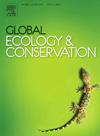Casting light out of shadows: Assessing the coverage of data on endemic firefly distribution in the Atlantic Forest
IF 3.5
2区 环境科学与生态学
Q1 BIODIVERSITY CONSERVATION
引用次数: 0
Abstract
The Atlantic Forest holds the greatest diversity of fireflies on Earth. Although the knowledge about lampyrids in the Atlantic Forest has increased in the last 10 years thanks to the efforts of new taxonomists and ecologists, both the total number of species and their geographic ranges remain largely unknown. Furthermore, the Atlantic Forest has been facing intense deforestation since the XV century, and now only 23 % of the natural vegetation cover remains, resulting in high vulnerability of its endemic species. Here, we assess the quality and coverage of the information available on the distribution of Lampyridae fireflies; i.e. the extent of the so-called Wallacean shortfall. To do this, we used a database that comprises 3010 records with geospatial and taxonomic information to evaluate the overall coverage of the geographical and environmental distribution of fireflies in the Atlantic Forest. Our assessment shows that the knowledge of Atlantic Forest's firefly diversity and distribution presents significant spatial and climatic biases. Firefly species remain largely under-collected in the Atlantic Forest; only around 16 % of its grid cells at a 50 km scale are well-sampled, and most of them are located in the Serra do Mar bioregion. The location of well-sampled cells is conditioned by recorders’ survey bias and is particularly biased towards protected areas, large forest remnants, the proximity to institutions holding entomological collections, and light-polluted sites surrounding urban spaces. Our findings also highlight that a considerable number of firefly species may remain undiscovered, which adds to the lack of reliable information on the geographic location of many valid species. Based on this assessment, we further point to areas where more sampling effort would provide maximum benefits in terms of geographical and environmental coverage, thus maximizing its value for biodiversity knowledge and conservation.从阴影中投射光明:评估大西洋森林特有萤火虫分布数据的覆盖范围
大西洋森林拥有地球上最丰富的萤火虫种类。虽然在过去十年中,由于新的分类学家和生态学家的努力,人们对大西洋森林中的萤火虫有了更多的了解,但物种总数及其地理分布范围在很大程度上仍然不为人知。此外,大西洋森林自十五世纪以来一直面临着严重的森林砍伐,现在只剩下 23% 的自然植被覆盖,导致其特有物种非常脆弱。在此,我们评估了现有的关于灯节萤火虫分布信息的质量和覆盖范围,即所谓的华莱士缺口的程度。为此,我们使用了一个由 3010 条记录组成的数据库,其中包含地理空间和分类信息,以评估大西洋森林中萤火虫地理和环境分布的总体覆盖范围。我们的评估表明,对大西洋森林萤火虫多样性和分布的了解存在明显的空间和气候偏差。大西洋森林中的萤火虫物种大部分仍未得到充分采集;在50公里范围内,只有约16%的网格单元得到了充分采样,其中大部分位于Serra do Mar生物区。取样良好的单元格的位置受记录员调查偏差的影响,尤其偏向于保护区、大型森林遗迹、昆虫学收藏机构附近以及城市空间周围的光污染地点。我们的研究结果还强调,相当多的萤火虫物种可能仍未被发现,这使得许多有效物种的地理位置更加缺乏可靠的信息。在这一评估的基础上,我们进一步指出了一些地区,在这些地区,更多的采样工作将在地理和环境覆盖方面带来最大的益处,从而最大限度地提高其对生物多样性知识和保护的价值。
本文章由计算机程序翻译,如有差异,请以英文原文为准。
求助全文
约1分钟内获得全文
求助全文
来源期刊

Global Ecology and Conservation
Agricultural and Biological Sciences-Ecology, Evolution, Behavior and Systematics
CiteScore
8.10
自引率
5.00%
发文量
346
审稿时长
83 days
期刊介绍:
Global Ecology and Conservation is a peer-reviewed, open-access journal covering all sub-disciplines of ecological and conservation science: from theory to practice, from molecules to ecosystems, from regional to global. The fields covered include: organismal, population, community, and ecosystem ecology; physiological, evolutionary, and behavioral ecology; and conservation science.
 求助内容:
求助内容: 应助结果提醒方式:
应助结果提醒方式:


